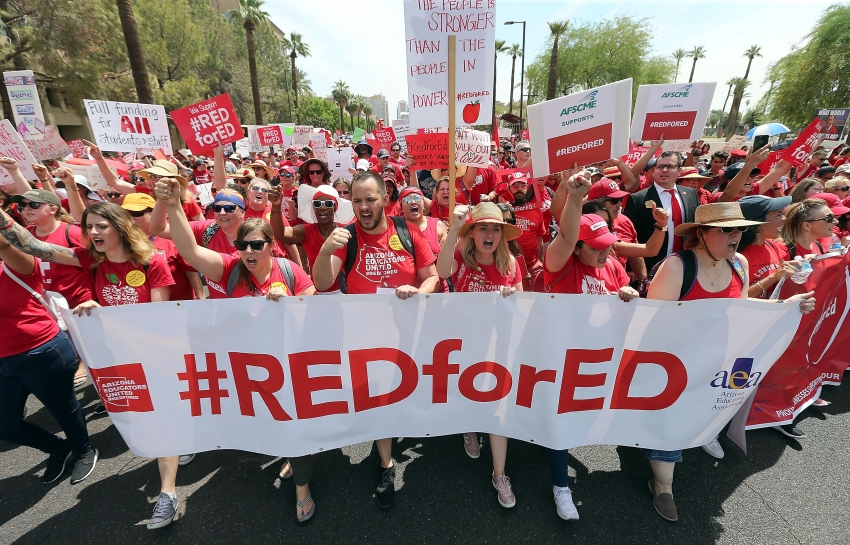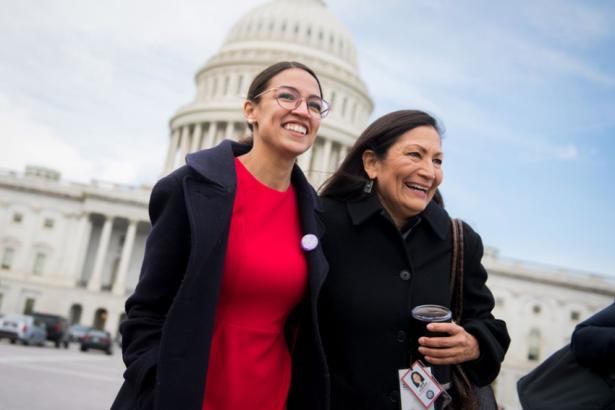The Left Victories That Defined 2018 — And Give Us Hope for the New Year - Marc Daalder
How the Left Can Win in 2020: Primary Centrist Democrats in Blue Districts - Sean McElwee
The Left Victories That Defined 2018 — And Give Us Hope for the New Year
Despite Trump’s destructive presidency, the Left made important strides this year—from electoral victories to strikes, union campaigns, movement organizing and popularizing left-wing policies.
By Marc Daalder
December 20, 2018
In These Times

credit: Ralph Freso/Getty Images // In These Times
In many ways, 2018 was a political garbage fire of a year. From the confirmation of conservative justice Brett Kavanaugh to the Supreme Court to the imposition of fascist border policies to President Trump’s continued attacks on everything from workers’ rights to the very planet itself, the year saw plenty of reasons for dismay.
But it wasn’t all bad. There were a number of important victories over the course of 2018 that are worth celebrating and remembering. Left-wing activism today shouldn’t just be about opposition to the Trump administration but must also focus on moving the country in a progressive direction and building a long-term movement capable of achieving lasting change.
In that spirit, here are 10 big wins the left achieved in the United States in 2018:
Progressive Primary Wave
As voters went to the polls for primaries between March and September, a number of progressive challengers won stunning upsets. Chief among these was Alexandria Ocasio-Cortez, the then-28-year-old open democratic socialist who unseated powerful House Democrat Joe Crowley in New York’s 14th congressional district. Wisconsin ironworker Randy Bryce won his primary with the aim of tackling Paul Ryan in the general election. Although Ryan ultimately decided not to run for reelection and Bryce lost to the Republican’s successor, the primary victory still put progressive Wisconsin politics back on the map. Other noteworthy left primary wins were Ilhan Omar in Minnesota, Rashida Tlaib in Michigan Ayanna Pressely in Massachusetts, Stacey Abrams in Georgia and Andrew Gillum in Florida. Overall, the primary season showed that the Democratic Party’s left flank is ascendant.
Medicare for All and a Green New Deal Gain Overwhelming Support
An August poll found that a full 70 percent of Americans, including 52 percent of Republicans, back Medicare for All—the highest level of public support ever recorded. The single-payer plan, which was considered pie-in-the-sky by liberal commentators when pushed by Sen. Bernie Sanders during the 2016 presidential primaries, now has support from 124 House members and 16 senators, including most high-profile likely 2020 presidential contenders. Healthcare was also the top concern for voters in the 2018 midterms, making Medicare for All the obvious policy choice for Democrats who want to win on the issue of healthcare.
And it wasn’t just universal healthcare. Another bold and transformative policy also gained enormous support this year: The Green New Deal. The plan, pushed by Ocasio-Cortez and others, would move the United States to 100 percent renewable energy through a transition away from fossil fuels, infrastructure improvements, a massive public jobs programs and other major policy changes. A poll from Data for Progress in September put support for a Green New Deal at 55 percent, but a more recent survey showed the proposal with 81 percent behind it, including strong bipartisan backing. And 35 members of Congress have now come out in support of the plan.
Taking Back the House
On November 6, Democrats took back the House of Representatives in stunning fashion, ending two long years of one-party rule in Washington. Democrats won by the largest margin in U.S. midterm history—smashing the 1974 “Watergate midterm” record by 100,000 votes. With a House majority, Democrats are poised to do more to keep the Trump administration in check while halting Trump’s legislative endeavors. Progressives, meanwhile, can introduce their own legislation—from Medicare for All to free college and a Green New Deal—and push moderate Democrats left on healthcare, labor, foreign policy and more.
Youth Activism
Although it was provoked by the tragic school shooting in Parkland, Fla., the March for Our Lives kicked off a new wave of student activism. Gun control—at the core of this movement—is a worthwhile goal, but its impact reaches even beyond this single issue, as 2018 saw youth political involvement surge. A record 31 percent of youth turned out to vote in the November midterms, Teen Vogue reports. The prior record for youth vote during a midterm election was just 21 percent in 1986. Young people are also attending more demonstrations and protests. Nearly 20 percent of Americans say they have attended a protest since 2016 and there were more demonstrations inMarch (when the March for Our Lives took place), April and June than in any other month since Trump’s inauguration. While these gains may not all be directly connected to the March for Our Lives, it’s clear that the movement has inspired Americans of all ages and backgrounds to increase their political involvement.
Red-state Teachers’ Strikes
While students walked out of their classrooms across the country to protest the scourge of gun violence, teachers were preparing their own disruption. A 13-day strikeby West Virginia teachers, which won a 5 percent pay increase, launched a cascade of actions around the nation. Teachers walked off the job statewide in Oklahoma—where a 1990s-era ballot measure makes raising taxes prohibitively difficult, and where nearly 20 percent of schools are only open four days a week. Another statewide teacher strike followed in Arizona in April. Colorado, Kentucky and North Carolina also saw strikes in numerous counties, and Los Angeles teachers ended the year with a march of 50,000 people ahead of a citywide strike set to begin January 10. Look for the wave to keep spreading in 2019.
Graduate Student Union Organizing
A new labor front has opened in the field of higher education—the rights of graduate student workers. Student workers at private and public universities alike have championed the cause of graduate student unions in 2018. Grad students at Columbia University, Fordham University, Brandeis University, Loyola University Chicago, Georgetown University and Brown University have all seen major gains this year, from union recognition to contract negotiations to successful strike actions. These victories have come in the face of the Trump NLRB’s attacks on grad workers’ rights.
Stopping Keystone XL
One of the top left-wing victories of 2015, the halting of the Keystone XL Pipeline, saw a redux in 2018. After President Obama halted the pipeline in 2015 (and, later, the Dakota Access Pipeline), Trump signed executive orders starting the process back up again in 2017. DAPL became operational later that year and already leaked five times in 2017, according to the Intercept. Meanwhile, Keystone XL has been mired in legal troubles—including, most consequentially, a federal court order in November of this year that blocked any further work on the pipeline until the Trump administration undertakes a serious review of its climate impact. The ruling came after years of carefully-coordinated activism from a coalition of environmental and indigenous rights groups.
Backlash to Yemen War
The October killing of journalist Jamal Khashoggi by Saudi Arabian agents in the kingdom’s consulate in Istanbul was a tragedy the made headlines across the globe. And while the Trump administration offered a nonchalant response to the murder, the U.S. president’s refusal to take meaningful action provoked a bipartisan backlash against U.S. policy towards Saudi Arabia. This helped lead to a historic Senate rebukeof the Saudi-led and U.S.-funded war in Yemen, which has claimed thousands of lives and led the country to the brink of catastrophic famine. Although the House didn’t follow suit, a new Democrat-led House could well do so in 2019.
Draining Trump’s Swamp
Being a member of the Trump administration has never come with much job security, and in 2018, even more corrupt officials were forced out of the White House by popular pressure. EPA head Scott Pruitt was made to resign in July after his bizarre scandals threatened to sink the administration’s vindictive environmental agenda. Likewise, the ousters of oil mogul-turned-Secretary of Defense Rex Tillerson in March and Interior Secretary Ryan Zinke in December are worth celebrating. While the November firing of Attorney General Jeff Sessions threatened the integrity of the investigation into Trump’s Russian connections, it also meant there would be one less racist in the Department of Justice. Activists worked tirelessly this year to repeatedly draw attention to the corruption of major Trump officials, and their work paid off.
Radicalizing Silicon Valley
The many abuses of Silicon Valley companies—from the mishandling of private data by Facebook to anti-unionization drives and harsh conditions in Tesla factories—made headlines in 2018. Underneath the frontpages, however, is a different story: that employees are fighting back. This year saw a new form of labor movement come to the fore in the tech industry, as Google employees wrote an open letter not in protest of work conditions but to demand that their company not cooperate with either Chinese censorship or the Pentagon. Likewise, Microsoft employees agitated against the corporation’s contract with ICE and Amazon workers called on Jeff Bezos to stop supplying facial recognition technology to law enforcement. Big tech has enormous potential—and with that potential comes a responsibility that many Silicon Valley workers appear eager to uphold.
All in all, 2018 was a mixed bag. The year saw more vile disregard for human dignity from the Trump administration, but it was also marked by fierce and effective resistance to every aspect of the Trump agenda. Let’s take that fighting spirit into 2019 to secure even more victories for marginalized people, workers and the environment.
[Marc Daalder is a journalist based in Detroit, Michigan and Wellington, NZ who writes on politics, public housing, and international relations. Twitter: @marcdaalder.]
How the Left Can Win in 2020: Primary Centrist Democrats in Blue Districts
Progressives such as Alexandra Ocasio-Cortez, Deb Haaland and Rashida Tlaib show how insurgent candidates can push the whole party left.
By Sean McElwee
December 10, 2018
In These Times

credit: Zach Gibson/Getty Images // In These Times
The Blue Wave that wiped out the Republican House majority brought a number of surprises in heavily GOP districts: Kendra Horn now holds a seat in deep-red Oklahoma, and Joe Cunningham pulled through in South Carolina. But even as Democrats seemed to win House races everywhere, many candidates upon whom progressive organizations staked big bets came up short. Randy Bryce (Wis.), Jess King (Pa.), Liuba Grechen Shirley (N.Y.), Ammar Campa-Najjar (Calif.) and Leslie Cockburn (Va.), all contesting red seats and endorsed by insurgent progressive groups, lost. One reason is simple: They were in tougher-than-average districts. But the other problem is strategic: Backing bomb-throwers in purple and red districts is not how to pull the party left.
One theory of change guiding some campaigns this cycle has been that an unapologetic left platform could boost turnout and win over working-class voters in Republican areas where Bernie Sanders performed well in the 2016 Democratic primary. The problem, of course, is that Bernie was running in the Democratic primary—his success doesn’t tell us what general election voters want in these districts. This is not to say that a Medicare-for-All candidate cannot win, simply that Democratic primaries offer the best hope to get insurgent candidates in office and pull the party left.
To see why, merely count the unabashed progressives who won primary challenges in safe Democratic districts, then sailed to victory in the general election: Alexandria Ocasio-Cortez (N.Y.), Deb Haaland (N.M.), Chuy Garcia (Ill.), Rashida Tlaib (Mich.), Jahana Hayes (Conn.), Joe Neguse (Colo.), Ayanna Pressley (Mass.), Ilhan Omar (Minn.). Only one retiring Democrat, Rep. Collen Hanabusa (Hawai’i), was replaced by someone who is likely to be to their right. Meanwhile, no progressive who unseated a Democratic congressional incumbent in the primary went on to lose the general election.
Look also, for instance, at how Ocasio-Cortez has already shifted the conversation around a Green New Deal, which an increasing number of Democrats have now embraced. Run left candidates to seize the safe blue districts, and the mainstream of the party will follow.
It’s tempting to shrug off the question of purple districts versus blue districts with a dismissive, “Why not both?” But progressive organizations simply don’t have enough money, media or organizers to aggressively contest primaries in both blue and purple districts. This will be even harder in 2020, when the presidential election is sure to distract from down-ballot races.
Support for these blue-district insurgents will come from unexpected places. Among the Left, there has been some dismissiveness toward the anti-Trump Resistance, as represented by groups such as Indivisible and Swing Left; many have painted them as centrists averse to challenging Democrats.
This myth (often rooted in misogyny—the Resistance is predominantly women) does not find support in research conducted by Data for Progress, the think tank I co-founded. We found that Democrats with favorable views toward Indivisible, compared to Democrats as a whole, are more supportive of contested primaries. This finding makes sense: These groups are full of engaged voters who vote in primaries and are sympathetic to the idea that Democratic leadership should be doing more to take on Trump.
A glance at the Indivisible endorsements points to an organization unafraid to support anti-establishment candidates. In New York, six state senate primaries were led by Indivisible and other Resistance groups. Indivisible led an upset by a grassroots favorite, Dana Balter, over the favored candidate of the establishment-friendly Democratic Congressional Campaign Committee, the House Democrats’ fundraising arm. While many progressive organizations struggle to have a genuine local presence (and increasingly struggle for money), Resistance groups could be an important base for primary challengers.
Although many progressive campaigns lost in swing districts, there is no reason why red-to-blue candidates can’t support Medicare for All. One recent poll of five swing districts found that single-payer healthcare had net positive support in all of them. As progressives gain electoral power in deep blue districts, they’ll be pulling the party toward public opinion, not away from it.
Most red-to-blue Democrats, those who flipped Republican House seats, supported some guarantee of universal healthcare, a public option, or even Medicare for All, like Sean Casten (Ill.), Susan Wild (Pa.), Josh Harder (Calif.), Katie Porter (Calif.) and Haley Stevens (Mich.), all of whom won in suburban swing districts. Four years ago, only one of these five districts had a pro-single-payer Democratic candidate in the general election. They weren’t the insurgents that many on the Left were most excited about, but their platforms show that insurgent ideas are gaining ground.
To keep the party moving left and advance progressive policies, we need a solid backbone of at least three dozen left progressives in the House to hold the line. That means in 2020 running primary challenges in safe Democratic seats with a slate of young, diverse progressive candidates.
[Sean McElwee is a co-founder of Data for Progress and tweets at @SeanMcElwee.]
Support Progressive Journalism
Donations from readers like you make up a full third of our annual income—that's how critical our end-of-year fundraising drives are. If you want to continue to read independent, progressive journalism in 2019 and beyond, we hope you'll consider chipping in whatever you can today.
For a limited time, anyone who makes a donation of $5 or more to In These Timeswill get a free copy of Verso's best-selling 2019 Radical Diary and Weekly Planner.
Reprinted with permission from In These Times. All rights reserved. Portside is proud to feature content from In These Times, a publication dedicated to covering progressive politics, labor and activism. To get more news and provocative analysis from In These Times, sign up for a free weekly e-newsletter or subscribe to the magazine at a special low rate.
Never has independent journalism mattered more. Help hold power to account: Subscribe to In These Times magazine, or make a tax-deductible donation to fund this reporting.


Spread the word